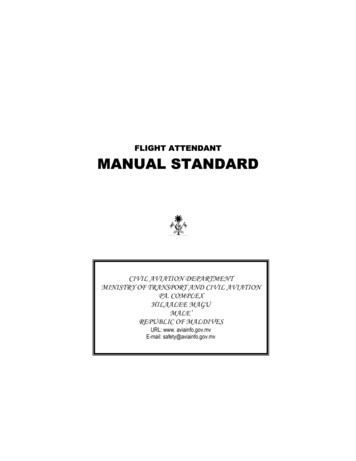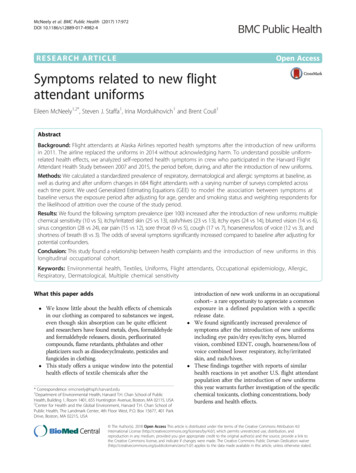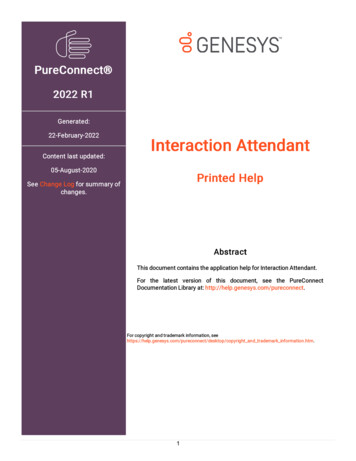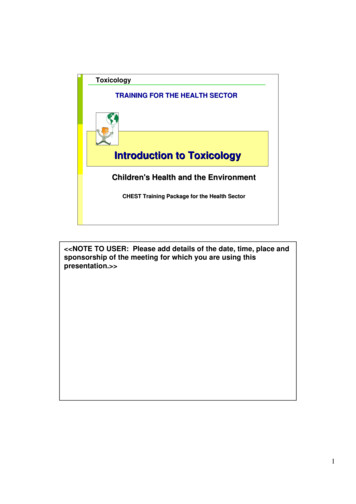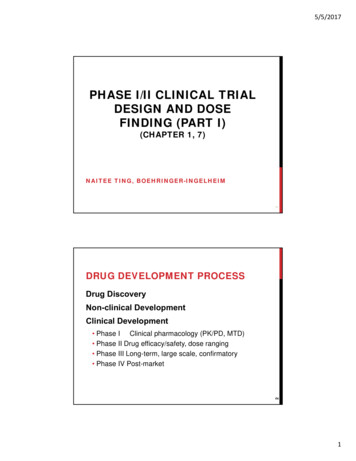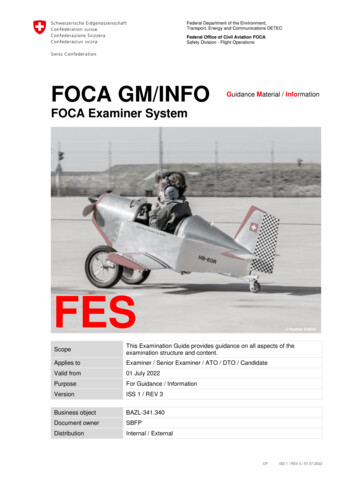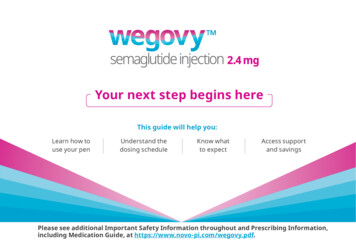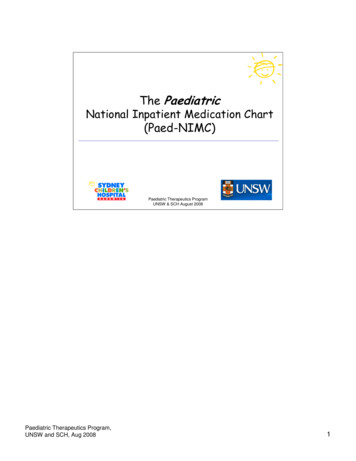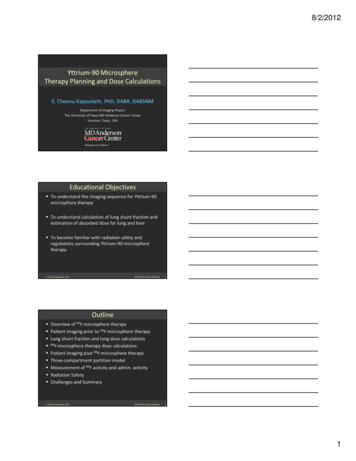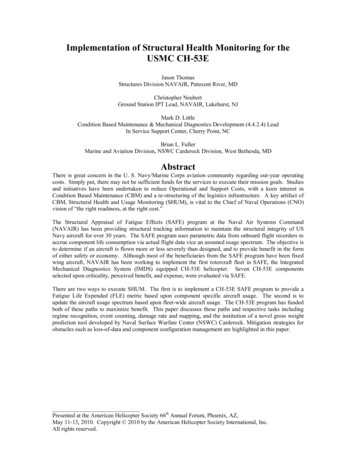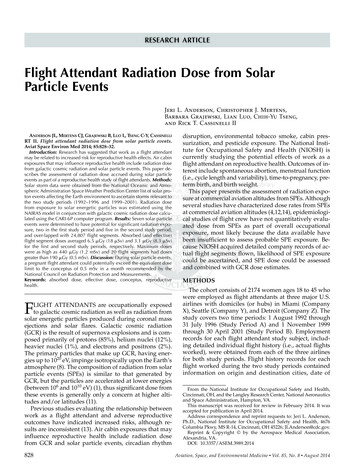
Transcription
RESEARCH ARTICLEFlight Attendant Radiation Dose from SolarParticle EventsJeri L. Anderson, Christopher J. Mertens,Barbara Grajewski, Lian Luo, Chih-Yu Tseng,and Rick T. Cassinelli IIANDERSON JL, MERTENS CJ, GRAJEWSKI B, LUO L, TSENG C-Y, CASSINELLIdisruption, environmental tobacco smoke, cabin presRT II. Flight attendant radiation dose from solar particle events.surization, and pesticide exposure. The National InstiAviat Space Environ Med 2014; 85:828–32.tute for Occupational Safety and Health (NIOSH) isIntroduction: Research has suggested that work as a flight attendantcurrently studying the potential effects of work as amay be related to increased risk for reproductive health effects. Air cabinexposures that may influence reproductive health include radiation doseflight attendant on reproductive health. Outcomes of infrom galactic cosmic radiation and solar particle events. This paper deterest include spontaneous abortion, menstrual functionscribes the assessment of radiation dose accrued during solar particle(i.e., cycle length and variability), time-to-pregnancy, preevents as part of a reproductive health study of flight attendants. Methods:termbirth,B.andbirth weight.DeliveredPublishingStephenThackerCDC LibrarySolar storm data were obtainedfrom thebyNationalOceanicTechnologyand Atmo- to:spheric Administration Space Weather PredictionCenter list of solarOn:pro-Tue, 29IP: 158.111.4.53Jul paper2014 18:19:26Thispresents the assessment of radiation expoton events affecting the Earth environment to ascertainstorms ation altitudes from SPEs. Althoughsure at commercialthe two study periods (1992–1996 and 1999–2001). Radiation doseseveral studies have characterized dose rates from SPEsfrom exposure to solar energetic particles was estimated using theat commercial aviation altitudes (4,12,14), epidemiologiNAIRAS model in conjunction with galactic cosmic radiation dose calculated using the CARI-6P computer program. Results: Seven solar particlecal studies of flight crew have not quantitatively evaluevents were determined to have potential for significant radiation expoated dose from SPEs as part of overall occupationalsure, two in the first study period and five in the second study period,exposure, most likely because the data available haveand over-lapped with 24,807 flight segments. Absorbed (and effective)been insufficient to assess probable SPE exposure. Beflight segment doses averaged 6.5 mGy (18 mSv) and 3.1 mGy (8.3 mSv)for the first and second study periods, respectively. Maximum dosescause NIOSH acquired detailed company records of acwere as high as 440 mGy (1.2 mSv) and 20 flight segments had dosestual flight segments flown, likelihood of SPE exposuregreater than 190 mGy (0.5 mSv). Discussion: During solar particle events,could be ascertained, and SPE dose could be assesseda pregnant flight attendant could potentially exceed the equivalent doseand combined with GCR dose estimates.limit to the conceptus of 0.5 mSv in a month recommended by theNational Council on Radiation Protection and Measurements.Keywords: absorbed dose, effective dose, conceptus, reproductiveMETHODShealth.FLIGHT ATTENDANTS are occupationally exposedto galactic cosmic radiation as well as radiation fromsolar energetic particles produced during coronal massejections and solar flares. Galactic cosmic radiation(GCR) is the result of supernova explosions and is composed primarily of protons (85%), helium nuclei (12%),heavier nuclei (1%), and electrons and positrons (2%).The primary particles that make up GCR, having energies up to 1020 eV, impinge isotropically upon the Earth’satmosphere (8). The composition of radiation from solarparticle events (SPEs) is similar to that generated byGCR, but the particles are accelerated at lower energies(between 106 and 1010 eV) (1), thus significant dose fromthese events is generally only a concern at higher altitudes and/or latitudes (11).Previous studies evaluating the relationship betweenwork as a flight attendant and adverse reproductiveoutcomes have indicated increased risks, although results are inconsistent (13). Air cabin exposures that mayinfluence reproductive health include radiation dosefrom GCR and solar particle events, circadian rhythm828The cohort consists of 2174 women ages 18 to 45 whowere employed as flight attendants at three major U.S.airlines with domiciles (or hubs) in Miami (CompanyX), Seattle (Company Y), and Detroit (Company Z). Thestudy covers two time periods: 1 August 1992 through31 July 1996 (Study Period A) and 1 November 1999through 30 April 2001 (Study Period B). Employmentrecords for each flight attendant study subject, including detailed individual flight history (i.e., actual flightsworked), were obtained from each of the three airlinesfor both study periods. Flight history records for eachflight worked during the two study periods containedinformation on origin and destination cities, date ofFrom the National Institute for Occupational Safety and Health,Cincinnati, OH, and the Langley Research Center, National Aeronauticsand Space Administration, Hampton, VA.This manuscript was received for review in February 2014. It wasaccepted for publication in April 2014.Address correspondence and reprint requests to: Jeri L. Anderson,Ph.D., National Institute for Occupational Safety and Health, 4676Columbia Pkwy, MS R-14, Cincinnati, OH 45226; JLAnderson@cdc.gov.Reprint & Copyright by the Aerospace Medical Association,Alexandria, VA.DOI: 10.3357/ASEM.3989.2014Aviation, Space, and Environmental Medicine x Vol. 85, No. 8 x August 2014
SOLAR PARTICLE EVENT DOSES—ANDERSON ET AL.dose rates and GCR dose rates as a function of timeflight, and local departure and arrival times. For each(hour-by-hour or dynamic data) or averaged over theflight segment, local departure and arrival times werestorm period (event-averaged). The dynamic data areadjusted for daylight savings time and converted tothe dose rates on a 5-degree 3 5-degree grid at altitudesUniversal Time (UTC). Information on commuter andfrom 0 to 90 km (roughly 230,000 data points per hour ofrecreational travel were generally included in the comthe storm for the dynamic data set).pany records; however, only flight date and origin andAlthough cruising altitude is variable for each flightdestination cities were available.segment, it was necessary to estimate a single most repFirst, radiation dose from exposure to cosmic radiaresentative altitude for each flight segment for SPE dosetion was estimated using the CARI-6P computer proestimation. A representative altitude for each flight seggram developed by the Federal Aviation Administrationment was chosen based on the distribution of weighted(FAA). CARI-6P estimates effective dose received by anaverage altitudes obtained from a data set containingindividual on an aircraft flying between any two geodetailed flight plans for all flights over a 2-5 d period forgraphic locations assuming a Great Circle route (20). Tothe three study companies (7). Dynamic SPE dose ratetal absorbed (mGy) and effective (mSv) dose (DCARI) fordata for the origin and destination city geomagnetic coeach flight segment was estimated using the CARI-6Pordinates for each flight segment were used to estimatecomputer program. Regression equations based on 6784SPE doses for official or “segment” travel (i.e., flightsflight plans from 1997 provided by the study companiesflown as part of the regular work schedule) because deand a previously developed algorithm were used totailed information on flight segments flown (i.e., origin/generate the required input data for radiation dose estidestination and arrival/departure times/dates) weremation using CARI-6P (i.e., taxi time, cruising altitudes,available:time at each cruising altitude) (7).Radiation dose from exposure to solar energetic parDeliveredby PublishingTechnology to: Stephen B. Thacker CDC Libraryticles was estimated usingthe Nowcastof AtmosphericIP: 158.111.4.53 On: Tue, 29 Jul 2014 18:19:261 § 1 T & I , 30% ³1 T & I , 30% ³ ¶Ionizing Radiation for Aviation Safety(NAIRAS)Aerospacemodel. MedicalCopyright: 30% Association #!2) r · The model was developed by scientists at the National2 T I 1 & I ,'#2 µ O RI T I 1 & I ,'#2 µ D EST ·Aeronautics and Space Administration (NASA) and isdescribed in detail elsewhere (14,15). Briefly, the NAIRASwhere ḊGCR 5 NAIRAS-calculated GCR dose rate atmodel is designed to provide real-time prediction ofthe flight segment origin or destination city; ḊSPE 5ionizing radiation exposure rates at commercial aviaNAIRAS-calculated SPE dose rate at the flight segmenttion altitudes. The NAIRAS code combines radiationorigin or destination city; DCARI 5 CARI-6P-calculatedtransport calculations with real-time measurementsGCR dose for flight segment; and t 5 time period of theof atmospheric density versus altitude and radiation inflight segment.cident on the Earth’s atmosphere to provide predicEvent-averaged SPE dose rate data were used to estitions of both galactic cosmic and solar particle eventmate SPE doses for commuter and recreational flightsradiation.because only flight date, (i.e., no departure and arrivalSolar storm data was obtained from the National Ocetimes) and origin/destination city were available:anic and Atmospheric Administraton (NOAA) SpaceWeather Prediction Center list of solar proton events af³ & 30% ³ ¶1 § &fecting the Earth environment (http://www.swpc.noaa. 30% #!2) r 30% ·gov/ftpdir/indices/SPE.txt). NOAA defines a solar2 & '#2 µ O RI & '#2 µ D EST · particle event as a flux of greater than 10 MeV protons atgreater than 10 particle flux units (pfu). Solar storms ofAbsorbed doses from solar particle events for flight seginterest in terms of significant radiation exposure werements that were below 10% of the minimum CARIassumed to be those storms with a solar proton flux6P-calculated absorbed dose from GCR for all flightgreater than 900 pfu. Once relevant solar storms weresegments were assumed to be within the estimated unselected, “date gates” were used to determine whether acertainty of dose from GCR and were set to zero. Flightflight segment occurred during the event and thus SPEsegment doses and cumulative doses estimates for indidose should be calculated. The date gates were set atvidual flight attendants were summarized using demidnight (00:00 UTC) 1 d prior to the beginning of thescriptive statistics.SPE and at midnight (00:00 UTC) 1 d after the end of theSPE. A flight segment was considered to occur duringRESULTSthe SPE if the flight segment start date/time or end date/time occurred between the date gates.Fig. 1 shows the study periods A and B in relation toFor each solar storm, NASA provided two data setsSolar Cycles 22 and 23, respectively. Study period A ocproduced using NAIRAS: one data set containing dycurs near the minimum at the end of Solar Cycle 22,namic (hour-by-hour) radiation absorbed and effectivewhereas study period B occurs near the maximum ofdose rate data covering each storm period and a secondSolar Cycle 23. Start and end dates and times, duration,data set containing the average radiation dose rate forand proton flux for each solar particle event are showneach entire storm period (event-averaged dose rate).in Table I. Solar storm proton flux (integral 5-min averages for proton energies . 10 MeV) varied betweenEach data set provided by NASA contained both SPEAviation, Space, and Environmental Medicine x Vol. 85, No. 8 x August 2014829
SOLAR PARTICLE EVENT DOSES—ANDERSON ET AL.from SPE radiation for each study period in comparisonto GCR doses calculated using CARI-6P during the sametime period. Median and 75th percentile absorbed doseper flight segment from SPE radiation for each of theseven SPEs by study company (Fig. 3) also reflect routedifferences between airlines which impact SPE exposure. Mean doses for commuter/recreational travel varied from 0.0040 mGy (0.016 mSv) for Event 2 (N 5 1 flightsegment) to 1.4 mGy (4.4 mSv) for Event 3 (N 5 96 flightsegments).DISCUSSIONThis is the first comprehensive assessment of SPE forover 2 million flights as part of an epidemiological study.Because these routes were flown by U.S. flight crewsFig. 1. Average monthly heliocentric potentials versus month/year forthe two solar cycles corresponding to the study periods of interest (21).and were primarily domestic flights, there are few datain the literature with which to compare these results.Clucas et al. (3) used the Atmospheric Radiation Model940 pfu for Event 5 (study period B) to 24,000 pfu forto calculate ambient-equivalent dose rates for a LondonEvent 3 (study period B). Only two solar storms of anyNew York flight at conventional aviation altitudespotential dose significance (out of seven) occurred durduring the 14 July 2000 solar storm (Event 3). Total aming study period A, which encompassed 4 yr, while fiveflightCDCdoseLibrarycalculated for the Londonsolar storms with potentialdosebysignificance (outof 20) ephen B. Thacker158.111.4.53On: Tue,New29 Jul201418:19:26Yorkflightwas 10 mSv compared to an effectiveoccurred during study period B, IP:whichencompassedCopyright: Aerospace MedicalAssociationdose of 633mSv calculated for the same route during theonly 1.5 yr.same event in this study. Lantos and Fuller estimatedFrom a total of 1,692,691 flight segments coinciding;70 and 50 mSv dose equivalent for Event 3 and Event 7with study period A and 461,536 flight segments coin(15 April 2001), respectively, for a Paris-San Franciscociding with study period B, 9890 (0.6%) and 14,917 (3%)Airbus A340 flight using the SiGLE model (10). Theseflight segments, respectively, were determined to haveexact flight routes were not part of the airline flightoccurred within the date gates established for SPE. Onlyschedules during the study periods; however, compara1411 (0.08% of total) flight segments in study period Able routes assessed in this study included London-Los(2 events) had significant (nonzero) SPE dose, whileAngeles (90 mSv) and Paris-San Jose, CA (202 mSv).6593 (1.4% of total) of flight segments in study period BCumulative doses from occupational exposure to SPE(5 events) had significant SPE dose. There were signifiradiation vary with the number and size of the SPEs thatcant doses in 752 flight segments designated as comoccur during a flight attendant’s work. Flights occurringmuter or recreational travel occurring during both studyduring periods of maximum solar activity are moreperiods combined.likely to coincide with SPE; however, dose received fromDescriptive statistics for absorbed and effective dosesan SPE occurring during a flight depends on the magniper flight segment resulting from exposure to SPE ratude of the event. Comparison of doses from GCR anddiation during each of the seven events are shown inSPE in Fig. 2 demonstrates the relatively constant andTable II and show the distributions to be highlyisotropic nature of GCR compared to the varying intenskewed. For calculation of SPE dose rates, the represensity and anisotropy of SPE radiation (2,10). Also, dosetive cruising altitude was determined to be the medianreceived during a SPE is strongly dependent on altitudetime-weighted average altitude for each flight segmentas well as geomagnetic latitude. For example, nonflying(10 km; mean 5 9.7 km; SD 5 1.5 km). Fig. 2 shows the calpregnant women in the three airline hubs of Miami,culated absorbed and effective doses per flight segmentTABLE I. STUDY-ASSOCIATED SOLAR PARTICLE EVENTS.EventStudy period A12Study period B34567aEvent StartaEvent EndaDuration (h)Proton Flux (pfu)20:00 30 Oct 199203:00 20 Feb 199416:00 04 Nov 199201:00 22 Feb 199411646270010,00011:00 14 Jul 200000:00 09 Nov 200017:00 24 Nov 200000:00 05 Apr 200114:00 15 Apr 200115:00 17 Jul 200010:00 11 Nov 200005:00 25 Nov 200013:00 08 Apr 200116:00 17 Apr 2001765812855024,00014,8009401110951Universal Time (UTC)830Aviation, Space, and Environmental Medicine x Vol. 85, No. 8 x August 2014
SOLAR PARTICLE EVENT DOSES—ANDERSON ET AL.TABLE II. ABSORBED AND EFFECTIVE DOSE PER FLIGHT SEGMENT FOR EACH STUDY-ASSOCIATED SOLAR PARTICLE EVENT.Absorbed Dose (mGy)Event1234567Effective Dose (mSv)NMean 6 SDMedianMaximumMean 6 SDMedianMaximum123817315851350440186913497.4 6 340.31 6 0.568.2 6 281.3 6 3.40.21 6 0.190.072 6 0.113.9 6 12320 6 920.85 6 1.622 6 733.6 6 9.60.53 6 0.490.20 6 0.3410 6 330Only significant (nonzero) doses are included.Seattle, and Detroit (essentially at sea level) duringVariation in SPE dose rates with time is also evident inEvent 3 were potentially exposed to peak dose rates ofthe difference between SPE doses estimated for actual0.085, 0.15, and 0.12 mSv · h21, respectively, and 5.4 andknown flight segments using dynamic data versus SPEdoses estimated for commuter/recreational travel flight4.2 mSv · h21 in London and New York, respectively.segments using event-averaged data, likely resulting inBecause of the anisotropy of the SPE radiation duringunderestimation of SPE dose.a solar storm, using the Great Circle Route estimationThe FAA supports dose limits recommended by therather than the actual flight plan for a given flight to calCommissionon Radiological Protectionculate SPE dose can resultin significant underor over- to:InternationalDeliveredby PublishingTechnologyStephen B. ThackerCDC Libraryand theNational Council on Radiation Protecestimation (6,10). Additionally, SPErates varybyTue, (ICRP)IP: dose158.111.4.53On:29 Jul 201418:19:26Copyright:AerospaceAssociationtion andMeasurements (NCRP) (19). The ICRP recomseveral orders of magnitude with timeduring theevent Medicalmends an equivalent dose limit of 1 mSv to the embryo/(14). For example, effective dose rates at London Heathfetus for the remainder of the pregnancy and the NCRProw (at 6.2 mi/10 km altitude) varied from 0.00000018recommends an equivalent dose limit of 0.5 mSv permSv · h21 to 480 mSv · h21 during the course of Event 3,with the largest dose rates occurring during the first 3 hmonth to the embryo/fetus (9,16). Newly publishedof the storm (240-480 mSv · h21) and smaller dose ratesprotective guidance from the NCRP still recommends aoccurring for the remainder (maximum of 11 mSv · h21).0.5 mSv per month equivalent (18). During air travel, theThus, the hours during which flights between a givenbody is exposed uniformly (i.e., near-isotropic geomeorigin and destination occur during a SPE have a signifitry) to galactic and/or solar radiation, thus the effectivecant effect on the magnitude of the SPE dose as seen indose calculated by CARI-6P is a reasonable and conservathe large difference between the ambient-equivalenttive estimate of the equivalent dose to the conceptus (20).dose estimated by Clucas et al. (3) for the London-NewResearch has suggested that no damage to the concepYork flight and the effective dose calculated in this study.tus is observed at absorbed doses less than 50 mGyFig. 2. A) Absorbed and B) effective doses per flight segment from GCR and SPE radiation for study period A (1411 flight segments) and study periodB (6593 flight segments). Lines indicate data ranges (min, max) and boxes indicate the interquartile ranges. Only segments with significant (nonzero)estimated SPE dose are represented.Aviation, Space, and Environmental Medicine x Vol. 85, No. 8 x August 2014831
SOLAR PARTICLE EVENT DOSES—ANDERSON ET AL.REFERENCES1. Al Anid H, Lewis BJ, Bennett LGI, Takada M. Modelling of radiationexposure at high altitudes during solar storms. Radiat ProtDosimetry 2009; 136:311–6.2. Beck P, Bartlett DT, Bilski P, Dyer C, Fluckiger E, et al. Validationof modelling the radiation exposure due to solar particle eventsat aircraft altitudes. Radiat Prot Dosimetry 2008; 131:51–8.3. Clucas SN, Dyer CS, Lei F. The radiation in the atmosphere duringmajor solar particle events. Adv Space Res 2005; 36:1657–64.4. Copeland K, Sauer HH, Duke FE, Friedberg W. Cosmic radiationexposure of aircraft occupants on simulated high-latitudeflights during solar proton events from 1 January 1986 through1 January 2008. Adv Space Res 2008; 42:1008–29.5. De Santis M, Cesari E, Nobili E, Straface G, Cavaliere AF, CarusoA. Radiation effects on development. Birth Defects Res CEmbryo Today 2007; 81:177-82.6. Dyer C, Lei F, Hands A, Truscott P. Solar particle events in theQinetiQ atmospheric radiation model. IEEE Trans Nucl Sci2007; 54:1071–5.7. Grajewski B, Waters MA, Whelan EA, Bloom TF. Radiation doseestimation for epidemiologic studies of flight attendants. Am JFig. 3. Median and 75th percentile absorbed dose per flight segmentInd Med 2002; 41:27–37.from SPE radiation for each event for study company X (Miami domi8. Heinrich W, Roesler S, Schraube H. Physics of cosmic radiationcile), Y (Seattle domicile), and Z (Detroit domicile). Only segments withfields. Radiat Prot Dosimetry 1999; 86:253–8.significant (nonzero) estimated SPE dose are represented.9. ICRP. The 2007 Recommendations of the International Commissionon Radiological Protection. ICRP Publication 103. Ann ICRP2007; 37(2-4):1–332.(50 mSv equivalent dose) (5). However, a study of feLantos P, Fuller N. History of the solar particle event radiation dosesDelivered by Publishing Technology to:10.StephenB. Thacker CDC Libraryon-board aeroplanes using a semi-empirical model and concordemale veterinarians performing morethan five radioIP: 158.111.4.53On: Tue, 29 Jul201418:19:26measurements. Radiat Prot Dosimetry 2003; 104:199–210.graphic examinations per week indicateda statisticallyCopyright:Aerospace Medical11. LewisAssociationBJ, Bennett LGI, Green AR, McCall MJ, Ellaschuk B, et al.significant excess risk of spontaneous abortion (22). AcGalactic and solar radiation exposure to aircrew during a solarcycle. Radiat Prot Dosimetry 2002; 102:207–27.cording to the NCRP, average annual effective dose for12. Lewis BJ, Desormeaux M, Green AR, Bennett LG, Butler A,monitored veterinary workers varied between 0.28 andet al. Assessment of aircrew radiation exposure by further0.51 mSv for 2003–2006 (17).measurements and model development. Radiat Prot DosimetryThis study shows that although flight through a sig2004; 111(2):151–71.13. Magann EF, Chauhan SP, Dahlke JD, McKelvey SS, Watson EM,nificant SPE is a relatively infrequent occurrence on theMorrison JC. Air Travel and Pregnancy Outcomes: A Reviewcommercial routes in our sample, there is a potential forof Pregnancy Regulations and Outcomes for Passengers,a pregnant flight attendant working on a single flightFlight Attendants, and Aviators. Obstet Gynecol Surv 2010;traveling through an SPE to receive an effective dose in65(6):396–402.14. Mertens CJ, Kress BT, Wiltberger M, Blattnig SR, Slaba TS, et al.excess of the NCRP-recommended equivalent dose limitGeomagnetic influence on aircraft radiation exposure during ato the conceptus of 0.5 mSv per month and/or the ICRPsolar energetic particle event in October 2003. Space Weatherrecommended equivalent dose limit of 1 mSv for the2010; 8:S03006.pregnancy. Future enhancements of the NAIRAS system15. Mertens CJ, Meier MM, Brown S, Norman RB, Xu XJ. NAIRASaircraft radiation model development, dose climatology, andinclude a proposed 2-h warning system for SPE expoinitial validation. Space Weather 2013; 11:603–35.sure, which would allow for rerouting of flights more16. NCRP. Limitation of exposure to ionizing radiation. NCRPeffectively than the few minutes of warning currentlyReport No. 116. Bethesda, MD: National Council on RadiationProtection and Measurements; 1993.available to commercial airlines. Mitigation of exposure17. NCRP. Ionizing radiation exposure of the population of theto GCR and SPE radiation while pregnant could beUnited States. NCRP Report No. 160. Bethesda, MD: Nationalachieved by flying routes at lower altitudes/latitudesCouncil on Radiation Protection and Measurements; 2009.and/or reducing the amount of time spent flying.18. NCRP. Preconception and prenatal radiation exposure: healtheffects and protective guidance. NCRP Report No. 174.Bethesda, MD: National Council on Radiation Protection andACKNOWLEDGMENTSMeasurements; 2013.We thank David S. Evans for the processing and interpretation of19. Nicholas JS, Copeland K, Duke FE, Friedberg W, O’Brien KNational Oceanic and Atmospheric Administration satellite data. WeIII. Galactic cosmic radiation exposure of pregnant aircrewalso thank Xiaojing Xu of Science Systems and Applications, Inc., inmembers II. Washington, DC: Office of Aviation Medicine,Hampton, VA, for performing the conversion of flight segment geoFederal Aviation Administration; 2000. Report No.: DOT/graphic coordinates to geomagnetic coordinates.FAA/AM-00/33.The findings and conclusions in this report are those of the authors20. Nicholas JS, Copeland KA, Duke FE, Friedberg W, O’Brienand do not necessarily represent the views of the National Institute forK. Galactic cosmic radiation exposure of pregnant flightOccupational Safety and Health.crewmembers. Aviat Space Environ Med 2000; 71:647–8.Authors and affiliations: Jeri L. Anderson, M.S., Ph.D., Barbara21. O’Brien K, Burke GdP. Calculated cosmic ray neutron monitorGrajewski, M.S., Ph.D., Lian Luo, BE, Chih-Yu Tseng, B.S., M.S., andresponse to solar modulation of galactic cosmic rays. JournalRick T. Cassinelli II, B.S., Division of Surveillance, Hazard Evaluations,of Geophysical Research 1973; 78:3013–9.and Field Studies, National Institute for Occupational Safety and22. Shirangi A, Fritschi L, Holman CD. Maternal occupationalHealth, Centers for Disease Control and Prevention, Cincinnati, OH;exposures and risk of spontaneous abortion in veterinaryand Christopher J. Mertens, M.S., Ph.D., Science Directorate, Chemistryand Dynamics Branch, NASA Langely Research Center, Hampton, VA.practice. Occup Environ Med 2008; 65:719–25.832Aviation, Space, and Environmental Medicine x Vol. 85, No. 8 x August 2014
RT II. Flight attendant radiation dose from solar particle events. Aviat Space Environ Med 2014; 85:828 32. Introduction: Research has suggested that work as a ß ight attendant may be related to increased risk for reproductive health effects. Air cabin exposures that may inß uence reproductive health include radiation dose
